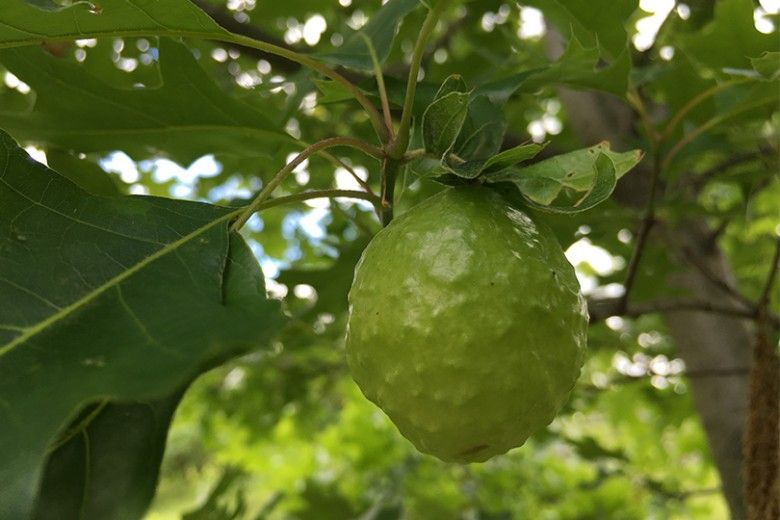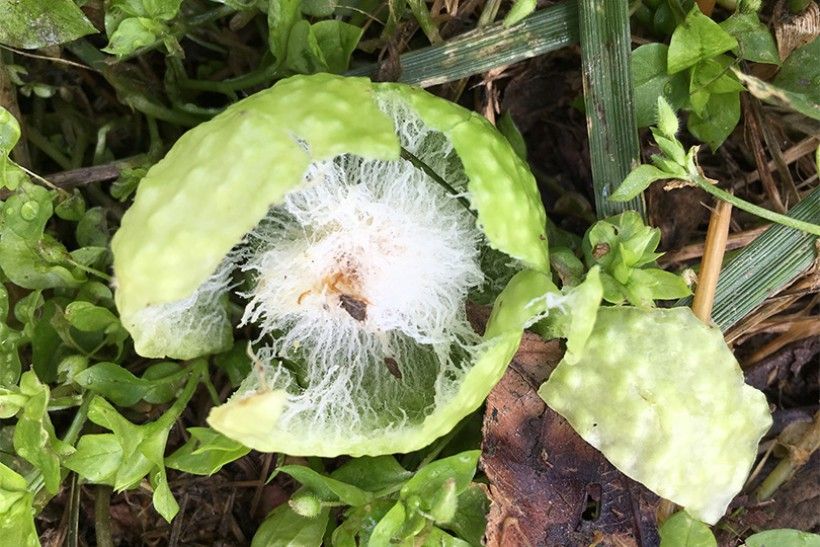How Wasps Make Beautiful and Complex “Oak Apples”

Recently, land stewardship staff came across these mysterious puff-balls on an oak tree while out in the field. With a little research, we learned that these are galls, sometimes known as “oak apples.”
“Oak apple galls” are leaves that have developed into a thin sphere because wasps have laid eggs inside of the leaf. Inside the gall is a tiny wasp larva. Most galls, especially on leaves, do not hurt the oak tree, and the wasps aren’t harmful to people either. In fact, like many insects, the wasps inside these galls are a beneficial source of food for our native wildlife, including many species of birds, as well as mammals such as opossums and raccoons. Galls have much to teach us about the complexity of the natural world around us, and demonstrate the importance of native tree species, such as oaks, for supporting biodiversity.
Oak apple wasps (Amphibolips confluent) are one of many insect species that rely only on oak trees, and have evolved a very specific method for living on oak trees. The entire life cycle of an oak apple gall wasp, spread over two years, happens on one single oak tree. The life cycle of the wasp begins underground, in the roots of the oak. Here, wasp larvae hatch and feed on roots of the oak tree. They develop into pupae, and then wingless adult females hatch from the pupae. In spring of the second year of the life cycle, the female adult wasps emerge from the ground and climb up the oak tree to the leaves. Then, they inject an egg into the veins of a newly growing leaf, and the gall begins to form.

As the egg hatches, chemicals and hormones released through fluid alter the leaf’s typical growth. Instead of developing into a typical leaf, the leaf develops these round balls to create the perfect tiny home for one wasp larva. The larva is in the center of the gall, and fibers extend from the center to the walls of the gall to keep the larvae safe and secure. When the larva reaches the right size, in June or July, it turns into a pupa, and then, finally, an adult wasp. The adult wasp exits the gall by making a hole, and the galls turn brown and sometimes drop to the ground. Males and females mate, and females burrow into the ground to lay eggs and begin the cycle again.
There are hundreds of insects that produce galls, even within a single oak tree. The oak apple gall wasp uses leaves, but galls can also be seen growing on twigs and other parts of plants. Other insects use different species of plants to create galls. And, many other organisms sometimes take advantage of a gall one larva has created, and repurpose it for their own use! Check out this David Attenborough video about different wasps and galls to learn more: http://bit.ly/2spKIf9.
Overall, between their roots, bark, trunks, and leaves, oak trees host hundreds and hundreds of insects in various life stages, which then serve as critical food sources for native wildlife. The oak apple gall is the perfect example of how much is truly going on just below the surface of a very common tree that we often walk right by. If we look a little more closely, we can catch a glimpse of the complex biodiversity we are surrounded by every day!